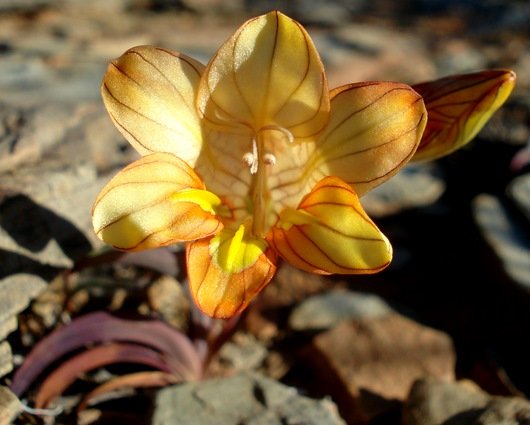Tritonia karooica

Author: Ivan Lätti
Photographer: Judd Kirkel Welwitch
Spring flowers of Tritonia karooica appear in large numbers in some years in parts of the Karoo. The dark brown veins on the tepals retain strong colouring to the margins, where they curve towards the tips.
The yellow, erectly ridged nectar guides on the lower three tepals in picture are unusual. Channelling pollinator traffic in the same fashion as passengers at airports is not a common floral feature.
The flowers are fragrant, more so towards evening and at night. Fragrance is a marketing feature of many flower species, aimed at attracting pollinators. Nectar serves the same purpose but is more important as it constitutes nourishment, not only enticement. Pollen is the male component of producing fruit and seed, also an important foodstuff for insects and other pollinators.
T. karooica plants are not browsed, improving their survival chances until the reproductive stage.
Longevity of all organisms is functional up to the reproductive stage. Parental usefulness continues in some cases for subsequent nurturing and caring of offspring. After this, returning old specimens to the direct food supply or in nutrient form after decay needs no delay, as far as nature is concerned.
Commonly browsed and grazed plants are not as lucky as this unappetising little geophyte! Some species get eaten in a big way. Countless herbivores with many tastes make plants a dominant food source or the dominant food source on earth. Animals themselves are a food source, some of them being carnivores, even cannibals. About all that lives eats something that lives and is eaten in turn by something else. All live in food chains and multidimensional, interdependent matrices.
The plants targeted by herbivores have to grow in greater numbers, grow bigger in size or develop repellent strategies including hairs, thorns and tannins in parts like leaves, to curb browsing. Failing to find at least one functional countermeasure leads to extinction of plant and animal species. This is how the world works in terms of survival of the fittest.
The human brain, the survival equipment of one species so far, has brought an exception. It has contrived a myriad of measures for escaping being eaten, to such an extent that they no longer form part of the "normal" food chains or other ecological systems involving sequences of feeding services among co-citizens. Thus nature has become warped; a temporary or terminal situation on earth (Shearing and Van Heerden, 2008; iNaturalist).

